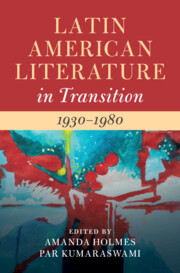Book contents
- Latin American Literature in Transition 1930–1980
- Latin American Literature in Transition
- Latin American Literature in Transition 1930–1980
- Copyright page
- Contents
- Contributors
- Introduction
- Part I War, Revolution, Dictatorship
- Part II Metropolis and Ruins
- Part III Solidarity
- Part IV Aesthetics and Innovation
- Chapter 14 Eros
- Chapter 15 The Return of the Galleons
- Chapter 16 “Un Híbrido de Halcón y Jicotea”
- Chapter 17 Literature and Revolution in Transition
- Chapter 18 Divergence and Convergence
- Chapter 19 Cortázar’s Transitional Poetics
- Index
Chapter 15 - The Return of the Galleons
Transitions in the Work of Alejo Carpentier
from Part IV - Aesthetics and Innovation
Published online by Cambridge University Press: 24 January 2023
- Latin American Literature in Transition 1930–1980
- Latin American Literature in Transition
- Latin American Literature in Transition 1930–1980
- Copyright page
- Contents
- Contributors
- Introduction
- Part I War, Revolution, Dictatorship
- Part II Metropolis and Ruins
- Part III Solidarity
- Part IV Aesthetics and Innovation
- Chapter 14 Eros
- Chapter 15 The Return of the Galleons
- Chapter 16 “Un Híbrido de Halcón y Jicotea”
- Chapter 17 Literature and Revolution in Transition
- Chapter 18 Divergence and Convergence
- Chapter 19 Cortázar’s Transitional Poetics
- Index
Summary
According to Carpentier, Columbus rounded, rounded off, and rounded up the planet at a very high cost for the Indigenous cultures of nuestra América (our America). Gradually, a new culture emerged from all the possible hybridizations of Europe, Africa, and Asia. Carpentier also stated that, in order for the novel to exist, there had to be a tradition: the first narratives were for domestic consumption, and it was not until the mid-twentieth century that the avalanche began with El reino de este mundo (The Kingdom of This World) and Los pasos perdidos (The Lost Steps). It was in effect the return to Europe of the galleons that once left Palos de Moguer in Spain, but now carrying another, different, culture. Several factors contributed to Carpentier’s awakening in postwar Europe: the dominance of fiction, somewhat exhausted by the weight of tradition and tired avant-garde formulas, was supplemented by a growing interest in the documentary, thanks to advances in photography and printing. Meanwhile, in Latin America a new approach to the novel was generated via storytelling, linking the particular to the universal. The historical novel was transformed and now demonstrated, alongside an only partially explored physical world, the questions that preoccupy all humankind.
Keywords
- Type
- Chapter
- Information
- Latin American Literature in Transition 1930–1980 , pp. 245 - 248Publisher: Cambridge University PressPrint publication year: 2022



